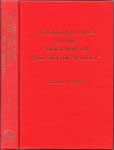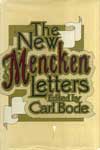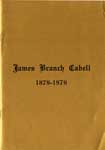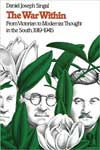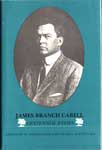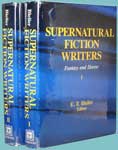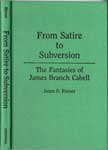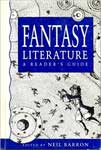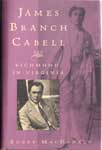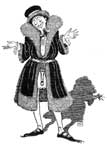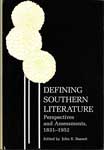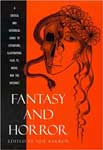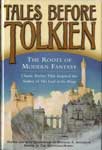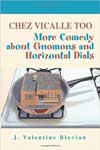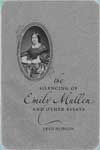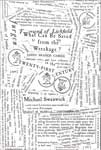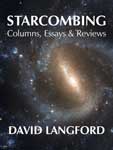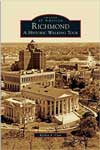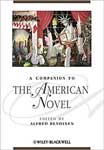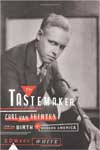The Silver Stallion
Writing About James Branch Cabell, 1975-2015
(A Supplement to Brewer 1958 and Duke 1979)
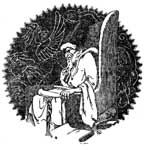 The list of writings about Cabell in Frances Brewer’s James Branch Cabell: A Bibliography of his Writings, Biography and Criticism (1957) runs only through 1956. Maurice Duke’s James Branch Cabell: A Reference Guide (1979) runs through 1975 but apparently not through the end of the year, so I have included his 1975 entries, marked with an *asterisk, along with my additions for 1975.
The list of writings about Cabell in Frances Brewer’s James Branch Cabell: A Bibliography of his Writings, Biography and Criticism (1957) runs only through 1956. Maurice Duke’s James Branch Cabell: A Reference Guide (1979) runs through 1975 but apparently not through the end of the year, so I have included his 1975 entries, marked with an *asterisk, along with my additions for 1975.
This supplementary bibliography will always be a work in progress. I mean to annotate it more thoroughly, to find more out-of-the-way entries, and to extend it beyond 2015 -- but if we wait until that’s all done it will never get posted. I have interpreted “about Cabell” somewhat more liberally than Brewer and Duke, so that some entries represent just a few mentions or several potted sentences about the Jurgen affair. Better more than less…
-- Bill Lloyd, March 2017
Bassett, John. William Faulkner: The Critical Heritage Routledge & Kegan Paul, 1975. See Abbott Martin 84-5; Laurence Bell 166-7; Aubrey Starke 170.
*Bregenzer, Don. A Round-Table in Poictesme. New York: Revisionist Press, 126 pp. Reprint of 1924 edition.
Brzustowicz, R., Jr. “Some Notes on Sources.” in Kalki No. 25 (1975), 25-27. Discusses Cabell’s creation of fictitious sources and possible sources for the Mirror & Pigeons.
*Duke, Maurice. "The Ornate Waste Land of James Branch Cabell," in The Twenties: Fiction, Poetry, Drama, Edited by Warren French. DeLand, Florida: Everett/Edwards, pp. 75-86. See 1974.B2.
Edlin, Gene, “Researches into the Dirghagama.” in Kalki No. 25 (1975), 31-33.
*Flora, Joseph M. "Cabell as Precursor: Reflections on Cabell and Vonnegut." Kalki, 6, No. 4, 118-137.
Duke: "Cabell prefigures Vonnegut."
---------. Introduction and notes to The Cream of the Jest: A Comedy of Evasions by James Branch Cabell. Albany, New College & University Press (1975).
Freiberg, Stanley K. “La Belle Dame and the Sestina.” in Kalki No. 25 (1975), 19-22.
Gabbard, G. N. “The Dance Version of Jurgen.” in Kalki No. 24 (1975), 115-117.
*Godshalk, William Leigh. In Quest of Cabell. New York: Revisionist Press, 97 pp. Reprint of 1967.B13; 1973.Bl; 1974.B3; plus "The Growth of A Credo: Beyond Life," which traces Cabell's reworking of that novel; and "Selected Bibliography," which includes Secondary sources.
Johnson, Paul. “Gleanings About Glaum.” in Kalki No. 25 (1975), 27-28. Suggests credibly that Glaum may derive from the ghost Glam in Grettir’s Saga.
*Kellner, Bruce. "Alfred Kazin's Exquisites—An Excavation." The Illinois Quarterly, 38 (Fall), 45-62.
Duke: In discussing a chapter that Kazin deleted from later editions of On Native Grounds, the author makes numerous references to Cabell.
*Meacham, Harry. "Cabell's Letters Show His Brilliance." Richmond News Leader (26 February), p. 13.
Duke: With the publication of this book, "We now have a full-length portrait of one of the truly great writers of this century...."
*Morley-Mower, Geoffrey. Cabell Under Fire. New York: Revisionist Press, 29 pp. Reprint of 1971.B9; 1972.B7; 1974.B5; plus "Cabell Under Fire," which retells the story of the suppression of Jurgen.
*----------. "Sinclair Lewis's Attempts to Reform James Branch Cabell." Kalki No. 25 (1975), 140-145. Reprint of 1975.A4. Duke: When Lewis first read The Cream of the Jest he misunderstood it.
----------. “Cabell Under Fire.” in Kalki No. 25, 1975, 5-13. Duke: “…retells the story of the suppression of Jurgen.”
*Schlegel, Dorothy B. James Branch Cabell: The Richmond Iconoclast. New York: Revisionist Press, 101 pp. Reprint of 1964.B6; 1968.B17; 1969.B30, B31; 1971.BIO.
*Scura, Dorothy. "Cabell's Personal Letters Illuminate the Author." Richmond Times-Dispatch (9 March), F, p. 5. Duke: What emerges from these letters is "a portrait of the writer—totally committed, serious, concerned about every aspect of his work."
Smith, James Penny. “Frances Newman and James Joyce” in James Joyce Quarterly Vol.12, No.3 (Spring 1975), 307-9. Cabell is quoted several times on Newman’s critical propensities and style.
*Wagenknecht, Edward. The Letters of James Branch Cabell. Norman: University of Oklahoma Press, 277 pp. Duke: The editor reproduces, with editorial comment, a number of Cabell's letters.
Warner, Richard. “The Illusion of Diabolism in the Cabellian Hero” in NOVEL: A Forum on Fiction 8.3, Spring 1975, 241-245.
Young, Stark – Stark Young, a Life in the Arts: Letters, 1900-1962 (2 volumes), John Pilkington, ed. Baton Rouge: Louisiana State University Press (1975). Several mentions of Cabell in letters to Ellen Glasgow and others, mostly to confess that he has never read his books.
Burgess, Peter C. The Female figure in selected works of James Branch Cabell. University of Calgary Master’s thesis. 190 pp. Not seen.
Dabney, Virginius. Richmond: The Story of a City. Doubleday, 1976. About ten substantive mentions of Cabell, including several quotations.
Holman, C. Hugh. “Ellen Glasgow and History: The Battle-Ground.” Prospects, Volume 2, October 1977, 385-398
Horan, Tom [Thomas]. Review of James Branch Cabell: A complete Bibliography by James N. Hall. Revisionist Press (1974) in Kalki No. 26 (1976), 58-60.
Hubbard, David D. Chivalry, Gallantry, and Artistry in James Branch Cabell's Biography of the Life of Manuel. Dissertation. Reed College, 1976. 442 pp.
Inge, M. Thomas. Ellen Glasgow: Centennial Essays. Charlottesville, University of Virginia Press (1976). Cabell referenced passim.
Jenkins, William D. “Anaitis in the Hebrides.” in Kalki No. 26 (1976), 68.
Litwhiler, Shirley Joyce Davis A Comparative Study of the Chivalric Satire of Ellen Glasgow and James Branch Cabell. Doctoral dissertation, Auburn University, 1976. 532 pp.
MacDonald, Edgar E. “The Fragmented Cabell.” in Southern Literary Journal 9.1, Fall 1976, 104-111.
----------, “An Essay in Bibliography” in Ellen Glasgow: Centennial Essays, M. Thomas Inge, ed. Charlottesville: University of Virginia (1976), 191-224. This essay is of course primarily concerned with works by and about Ellen Glasgow, but mentions or discusses Cabell on pages 195, 197, 198, 200, 201, 204, 205, 207, 208, 209, 212, 213, 215, 219 and 222.
Mateo, Maggey. “Cabell and the Mabinogion.” in Kalki No. 26 (1976), 47-50.
Morley-Mower, Geoffrey. Review of The Letters of James Branch Cabell, Edward Wagenknecht, ed. University of Oklahoma Press (1975) in Kalki No. 26 (1976), 39-46.
Rothman, Julius L. A Glossarial Index to ‘The Biography of the Life of Manuel’. New York: Revisionist Press (1976). 386 pp. A revision of the author’s 1954 Columbia University doctoral dissertation; contains an introductory essay and almost 300 pages of explanatory glosses to names and terms in Beyond Life, The Cream of the Jest, Figures of Earth, The High Place, Jurgen, The Music from Behind the Moon, Something About Eve, Straws and Prayer-books, The Way of Ecben and The White Robe. It is surprising that such a major work as The Silver Stallion is omitted from the list of those glossed.
Spencer, Paul. “ ‘Some Ladies’ and ‘Jurgen’.“ in Kalki No. 26 (1976), 51-57.
----------. “The Curious Contents of the Copper Dish.” in Kalki No. 26 (1976), 69.
Canary, Robert H. The Cabell Scene. New York: Revisionist Press (1977). 138 pp. A much-revised version of the author’s 1963 University of Chicago dissertation. Examines Cabell’s writing in the light of the work of Kenneth Burke, Freud and comic theory; handles a number of post-1930 works in addition to The Biography, *This title is listed in Duke’s Reference Guide under 1975 as “not seen.” Presumably it was then forthcoming and scheduled for 1975; but in the event it was not issued until 1977.
----------. “The Contexts for Cabell” in Kalki No. 27 (1977), 75-87.
Davidson, Donald. “A Mirror for Artists.” in I’ll Take My Stand: The South and the Agrarian Tradition, Louis D. Rubin Jr, ed. Baton Rouge: Louisiana State University Press (1977). Several substantive comments on Cabell.
Edlin, Gene K. “ReSearches in Tollab” in Kalki No. 27 (1977), 103-107.
Hinz, Evelyn J. & John Teunissen. “Life Beyond Life: Cabell’s Theory and Practice of Romance” in GENRE 10, Fall 1977, 229-327.
Jenkins, William D. “Iconomatopoeia.” in Kalki No. 27 (1977), 101-102
Mencken, H. L. The New Mencken Letters, Carl Bode, ed. New York: The Dial Press (1977). Includes several letters from Mencken to Cabell.
Rubin, Louis D., Jr. & Jerry T. Williams. Southern literature, 1968-1975: a checklist of scholarship. GK Hall & Company, 1978.
Spencer, Paul. “Cabell and the ‘Comics’ ” in Kalki No. 27 (1977), 89-92.
[Spencer, Paul & Leonard Wolinsky] “The Source of Melicent.” in Kalki No. 27 (1977), 100-101.
Squires, Roy A. James Branch Cabell: A Collection of His Works. Roy A. Squires, 1977. A bookseller’s catalogue so thorough it functions as a sort of bibliography.
Tarrant, Desmond. “James Branch Cabell: Wizard of the Unconscious.” in Kalki No. 27 (1977), 93-99.
Brooks, Cleanth. William Faulkner: Toward Yoknapatawpha and Beyond. New Haven: Yale University Press (1978). Contains numerous mentions of Cabell and his influence on Faulkner, especially the various references to and borrowings from Jurgen in several books.
Faulkner, William. Mayday. Notre Dame, Indiana: Notre Dame University Press (1978). As pointed out in the introduction by Carvell Collins, this early work by Faulkner, written in 1925 for a woman friend, is a close pastiche of Cabell's style, and is also tangentially related to The Sound and the Fury.
Fecher, Charles A. Mencken: A Study of his Thought. Knopf, 1978. A dozen mentions; see especially p.244.
Hobson, Fred C. Serpent in Eden: H. L. Mencken and the South. Baton Rouge: University of Louisiana Press (1978). An entire chapter (Chapter 6, pp. 121-146), titled "James Branch Cabell: The Last Aristocrat" is devoted to the Mencken–Cabell entente.. There are also numerous mentions elsewhere in the book of Cabell, his work, his reputation, and his relations with Mencken.
Inge, M. Thomas. "The Great Debate in Richmond." Prospects 3.1 (1978), 521-530. “... In the audience were Ellen Glasgow, Henry Seidel Canby, Norman Thomas, Howard Mumford Jones, HL Mencken, and James Branch Cabell, who, [Donald] Davidson reported, "had a front seat and listened intently, without blinking an eyelash or changing expression for two hours ...
Society for the Study of Southern Literature. Southern Literature 1968-1975: A Checklist of Scholarship. G. K. Hall, 1978. Cabell is covered on pages 49-52.
[Bond, Nelson]. “Wizard with a Pen” in MD Medical Magazine Vol.23 No.4 (April 1979), 111-116. Well illustrated biographical sketch of JBC, with a brief bibliography.
Duke, Maurice. James Branch Cabell: A Reference Guide. Boston: G. K. Hall (1979). A selected bibliography of the key books, chapters, articles and reviews concerning Cabell and his work from 1904 to 1975.
Emerson, O. B. and Marion C. Michael. Southern Literary Culture: A Bibliography of Masters' and Doctors' Theses (Revised and Enlarged Edition). University of Alabama Press, 1979. Lists 33 theses about Cabell’s works, produced between 1925 and 1969.
Flora, Joseph M “From Virginia to Poictesme: The Early Novels of James Branch Cabell” in Mississippi Quarterly, Vol. 32, No. 2 (1979), 219 ff.
Flora, Joseph M., and Louis Decimus Rubin. Southern Writers: a biographical dictionary. LSU Press, 1979.
Hall, James N. “Bibliographical Notes” [and Addenda] in Kalki No. 28 (1979), pp. 137-140, 143
Landow, George P. "And the world became strange: Realms of literary fantasy." in The Georgia Review (1979): 7-42.
Leiber, Fritz. “Titivated Romance” in: Blade of Conan, L. Sprague De Camp, ed.. New York: Ace (1979). pp. 189-203. Leiber’s piece on Jurgen was first published in 1966 in the Robert E. Howard fanzine Amra; it was then collected in The Conan Swordbook (1969), but is most easily available in this 1979 re-reprint. Leiber offers a nuanced view of Cabell, and particularly of Jurgen, from the point of view of a professional fantasy writer.
Post, J. B. The Atlas of Fantasy, New Revised Edition. Ballantine, 1979, 80-81. As in the 1973 first edition of the Atlas of Fantasy, this is Peter Koch’s map, Hall G8. It is a little smaller in the 1979 edition but benefits by not being split across two pages. The accompanying text is the same aside from an acknowledgment that Cabell’s Ballantine titles are now published by Del Rey.
Spencer, Paul. “Jurgen and the Ghost.” in Kalki No. 28 (1979), pp. 129-133. An examination of the revisions Cabell made to his early story “An Amateur Ghost” when he fitted it into the text of Jurgen; written to accompany a reprint of the story in this issue of Kalki.
Schweitzer, Darrell. [review of] “Figures of Earth” in Science Fiction Review, August 1979, Richard E. Geis, ed. Page 27. Schweitzer makes the interesting suggestion that a collection of Cabell’s shorter fantastic fiction would be a good thing.
Tymn, Marshall B., Kenneth J. Zahorski & Robert H. Boyer. Fantasy Literature: A Core Collection and Reference Guide. New York: R. R. Bowker (1979). Cabell has his own section of entries on pp. 57-60 and is also mentioned on nine other pages.
Vinson, James, and Donald L. Kirkpatrick. Novelists and prose writers. Vol. 2. Macmillan, 1979. General reference entry.
Wagenknecht, Edward. James Branch Cabell, 1879-1979: A Centenary Tribute. Charlottesville: University of Virginia Library. A pamphlet accompanying an exhibition at University of Virginia’s Alderman Library on the centennial of Cabell’s birth.
Attebery, Brian. The Fantasy Tradition in American Literature: From Irving to Le Guin. Indiana University Press (1980). Cabell mentioned on 20 pages.
Brown, Calvin S. "Faulkner, Criticism, and High Fashion." The Sewanee Review (1980), 631-641. “... The important things are the matters of demonstrated fact which Collins establishes for the literary context of Mayday, the two most important being the strong influence of James Branch Cabell and the organic relationship of Mayday to some of ...”
Duke, Maurice. "Cabell Rhymes with Rabble" in Seasoned Authors for a New Season: The Search for Standards in Popular Writing (Questions of Quality #2), Bowling Green, Ohio: Bowling Green University Popular Press (1980), 117-126
Fitzgerald, F. Scott, et al. Correspondence of F. Scott Fitzgerald. Random House (NY), 1980. Includes several letters to and from Cabell, as well as mentions of Cabell by Fitzgerald in other letters.
Kellner, Bruce. A Bibliography of the Work of Carl van Vechten. Westport, Connecticut: Greenwood Press (1980). Several mentions of Cabell
Le Guin, Ursula K. The language of the night: essays on fantasy and science fiction. Putnam Publishing Group (1980). The essay "From Elfland to Poughkeepsie." includes a brief but substantive comment on Cabell.
MacDonald, Edgar E. “Henry Sydnor Harrison: Southern Feminist.” in Southern Literary Journal 13.1, Fall 1980. Briefly discusses Cabell’s dislike of his cousin Harrison’s writing.
Manguel, Albert. Dictionary of Imaginary Places. (revised and expanded in 1987). Includes Poictesme, of course.
Morley-Mower, G[eoffrey]. F. “Cabell’s Black Imagination” in Kalki No. 29 (1980), 179-190.
Smith, Nelson J. Jesting Pilate: a critical study of the fictional world of James Branch Cabell. Diss. Indiana University, 1980.
Rubin, Louis D., Jr. “A Southerner in Poictesme, Part II” in Texas Quarterly 2 (3) Supplement, Autumn 1981, 50-81. Not seen.
Scura, Dorothy M. "Women in Glasgow's Novels." The Southern Literary Journal 14.1 (1981): 82-84. Quotes a letter from Glasgow to Cabell correcting an anecdote told in Ellen Glasgow: An Inscribed Portrait. Concludes that Cabell on Glasgow in print is not to be trusted.
Symons, Julian. Critical Observations. New Haven: Ticknor and Fields.(1981) Several mentions of Cabell in the piece on Frances Newman.
Wells, Arvin R. “James Branch Cabell” in Dictionary of Literary Biography, Volume 9: American Novelists 1900-45, James J. Martine, ed., Detroit: Gale Research Company (1981), 107-117. Contains a brief biographical sketch (with a few errors), a basic bibliography, and a good essay on Cabell’s work.
Abadie, Ann J. & Doreen Fowler, eds. Faulkner and the Southern Renaissance (Faulkner and Yoknapatawpha, 1981). University Press of Mississippi, 1982. Four mention of Cabell, including Faulkner’s liking for Rivet.
[Hall, Sharon K., ed.] “James Branch Cabell [:] 1879-1958” in Twentieth Century Literary Criticism, Volume 6. Sharon K. Hall & Dennis Poupard eds. Detroit: Gale Research Co. (1982), 60-79. It is not clear who compiled the entry on Cabell. Brief bio and bibliography followed by almost 20 pages of excerpts from critical writings about Cabell stretching from a review of The Eagle’s Shadow in 1904 to and essay by Maurice Duke in 1975.
Riemer, James D. The Fantasies of James Branch Cabell. Doctoral Dissertation. Bowling Green State University, 1982. This dissertation formed the basis for Riemer’s book on Cabell; see Riemer (1989).
Singal, Daniel Joseph. The War Within: From Victorian to Modernist Though in the South. Chapel Hill: University of North Carolina Press (1982). There are references to Cabell or his works on sixteen pages, and he is treated in some detail on pp.87-91 in the section on Ellen Glasgow.
Allen, Mark. “Enchantment and Delusion: Fantasy in the Biography of Manuel.” in James Branch Cabell: Centennial Essays. Baton Rouge: Louisiana State University Press (1983), 122-130.
Bleiler, E. F. The Guide to Supernatural Fiction. Kent State University Press, 1983. Primary entry, 94-100. Covers The Cream of the Jest, Jurgen, Figure of Earth, The Judging of Jurgen, The High Place, The Silver Stallion, The Music from Behind the Moon, Something About Eve, The White Robe, The Way of Ecben, Smirt, Smith, Smire, There Were Two Pirates, The Devil’s Own Dear Son, and The Witch-Woman.
de Camp, L. Sprague, Catherine Crook de Camp, and Jane Whittington Griffin. Dark Valley Destiny: The Life of Robert E. Howard. New York: Bluejay Books, Inc., 1983. Pp. 220-223 is dedicated to a discussion of Cabell, and in particular Howard's attraction to Something about Eve, which he used to rationalize his own failures with women.
Duke, Maurice & Daniel P. Jordan. A Richmond Reader, 1733-1983. Chapel Hill: University of North Carolina Press (1983). A discussion of Cabell and his milieu appears between pages 344 and 363.
Fiedler, Leslie A. “The Return of James Branch Cabell; or, The Cream of the Cream of the Jest.” in James Branch Cabell: Centennial Essays. Baton Rouge: Louisiana State University Press (1983), 131-141.
Flora, Joseph M. “After the James Branch Cabell Period.” in James Branch Cabell: Centennial Essays. Baton Rouge: Louisiana State University Press (1983), 65-80.
Godshalk, W[illiam]. L. “James Branch Cabell: The Life of his Design.” in James Branch Cabell: Centennial Essays. Baton Rouge: Louisiana State University Press (1983), 108-121.
Inge, M. Thomas & Edgar E. MacDonald, eds. James Branch Cabell: Centennial Essays. Baton Rouge: Louisiana State University Press (1983). Papers given at a conference commemorating the 1979 centenary of Cabell’s birth. Includes essays by Louis D. Rubin Jr., William L. Godshalk, Edgar E. MacDonald, Ritchie D. Watson, Dorothy Scura, Mark Allen, Joseph M. Flora and Leslie Fiedler.
Lawler, Donald L. “The Biography of the Life of Manuel.” in Survey of Modern Fantasy Literature, 5 volumes, Frank N. Magill, ed. Englewood Cliffs, NJ: Salem Press (1983), 95-115. There are also occasional mentions of Cabell elsewhere in the five volumes.
MacDonald, Edgar E. “Cabell as Prospero, Wylie as Miranda, in Richmond-in-Virginia” in Kalki No.30 (1983), 216-228.
----------. “Cabell in Love.” in James Branch Cabell: Centennial Essays. Baton Rouge: Louisiana State University Press (1983), 17-39.
----------. “James Branch Cabell: A Photographic Essay.” in James Branch Cabell: Centennial Essays. Baton Rouge: Louisiana State University Press (1983), 81-107.
Rawlings, Marjorie Kinnan. Selected Letters of Marjorie Kinnan Rawlings, Gordon E. Bigelow and Laura V. Monti, eds. University Press of Florida, 1983. Contains only one letter from Rawlings to Cabell, but he is mentioned sixteen times in other letters.
Rubin, Louis D., Jr. “A Virginian in Poictesme.” in James Branch Cabell: Centennial Essays. Baton Rouge: Louisiana State University Press (1983), 1-16.
Scura, Dorothy McInnis. “Cabell and Holt: The Literary Connection.” in James Branch Cabell: Centennial Essays. Baton Rouge: Louisiana State University Press (1983), 40-64.
Shackelford, Lynne P. “James Branch Cabell” in Critical Survey of Long Fiction, 2 volumes, Frank Magill, ed. Englewood Cliffs, NJ: Salem House (1983). The entry on Cabell, including a biographical sketch, critical assessment and select bibliography, occupies pp. 401-410.
Watson, Ritchie D., Jr. “James Branch Cabell: A Bibliographical Essay” in James Branch Cabell: Centennial Essays. Baton Rouge: Louisiana State University Press (1983), 142-179.
Cohen, Philip. “Faulkner’s Player and his Pawns: The Source of a Metaphor: in American Notes and Queries, 23, Sept-Oct 1984, 16-19. The source of the metaphor in question is Cabell’s Jurgen. [not seen]
Gimmestad, Victor E. Joseph Hergesheimer (Twayne’s American Authors Series) Boston: Twayne Publishers (1984). Numerous mentions of Cabell and his connections with Hergesheimer.
Godshalk, William L. “Wherein Is Set Forth a Brief Account of Cabell’s Early Career, With a Few Even Briefer Comments on Faulkner.” in Kalki No.31 (1984), 239-243.
Grover, Dorys Crow. “Cabell and Faulkner: Mythical Kingdoms Introduction” in Kalki No.31 (1984), 237-8.
Knight, George. "Robert E. Howard: Hard-Boiled, Heroic Fantasist." in The Dark Barbarian: The Writings of Robert E Howard, a Critical Anthology (1984), 117-134. Critics have set up barriers between Howard’s kind of ‘sword and sorcery’ and Cabell’s so-called ‘high fantasy,’ but Howard owned Cream of the Jest and enthusiastically reviewed Something About Eve.
McNeill, Warren A. “JBC – Reporter” in Kalki No.31 (1984), 259-261.
Mencken, H. L. and George Jean Nathan, eds. The American Mercury: Facsimile Edition of Volume I, January, February, March, April 1924. New York: Freedeeds Books, 1984. Includes Cabell’s “Once More, The Immortals” a review of Robert Nichols’ Fantastica, pp. 123-5. Also includes Joseph Hergesheimer’s piece on Lillian Gish in which Cabell is said to have modelled Jurgen’s Helen of Troy on Gish. The Mercury’s own index assigns this essay to page 387, but it is actually on page 397.
Merivale, Patricia. "Learning the Hard Way: Gothic Pedagogy in the Modern Romantic Quest." Comparative Literature 36.2 (1984), 146-161. Jurgen is one of the works the author considers, comparing it to Goethe’s Faust, Fowles’ The Magus, Mozart’s Magic Flute, Flaubert’s Temptation of St. Anthony, Hesse’s Steppenwolf, and Lindsay’s Voyage to Arcturus, among others.
Morley-Mower, Geoffrey & Joan Powell. “Cabell’s Mode of Quotation.” in Kalki No.31 (1984), 244-252.
Scott, Elizabeth Spindler. An Experiment in Southern Letters: The Reviewer, 1921-1925. Self-published, 1984. A bound Master's thesis submitted to the University of Richmond in 1985. A 507 page typescript, an exhaustive study of The Reviewer.
Steege, David. Common Ground: Mark Twain's and James Branch Cabell's use of a medieval setting. MS thesis. University of North Carolina at Chapel Hill, 1984. [not seen]
Tarrant, Desmond. “Mark Twain and Cabell: A Footnote” in Kalki No.31 (1984), 262-263.
Wagenknecht, Edward. Review of James Branch Cabell: Centennial Essays in Kalki No.31 (1984), 253-256.
MacDonald, Edgar E. “James Branch Cabell [:] 1879-1958” in Supernatural Fiction Writers: Fantasy and Horror, 2 Volumes, E. F. Bleiler, ed. New York: Charles Scribner’s Sons (1985),pp.789-796. A succinct and well-done biographical and critical summary of Cabell’s career.
Pizer, Donald. “The 1920s Fiction of James Branch Cabell: An Essay in Appreciation.” in Southern Quarterly 23.2 (1985), 55-74.
Putzel, Max. Genius of Place: William Faulkner's Triumphant Beginnings. Baton Rouge: Louisiana State University Press (1985). Several mentions of Cabell and his influence on Faulkner.
Riemer, James D. “The Innovative Fantasies of James Branch Cabell.” in Southern Quarterly 23.2 (1985), 75-86.
Rubin, Louis D., Jr., et al. The History of Southern Literature. Baton Rouge: Louisiana State University Press (1985). Cabell and his milieu covered on pages 270-282.
Seidel, Kathryn Lee. The Southern Belle in the American Novel. University Press of Florida, 1985. Eleven mentions of Cabell, mostly in connection with Ellen Glasgow and Frances Newman.
Spencer, Paul. “Cabell: Fantasist of Reality” in Exploring Fantasy Worlds, Darrell Schweitzer, ed. San Bernardino California: Borgo Press (1985), pp. 97-106. Kalki editor Spencer surveys the Cabell canon to argue that Cabell’s fantasies were not escapist but rather an attempt to grapple with the realities of life.
Watson, Ritchie Devon, Jr. The Cavalier in Virginia Fiction. Baton Rouge: Louisiana State University Press (1985). Cabell is discussed in detail on pp. 218-233, and mentioned passim. Particular attention is paid to Let Me Lie and The Rivet in Grandfather’s Neck.
Angoff, Charles & Thomas Yoseloff. The Man from the Mercury: a Charles Angoff memorial reader. Fairleigh Dickinson University Press, 1986. Memories of Mencken, Nathan and others including their dealings with Cabell.
Collins, Carvell. “Likeness Within Difference: Cabell and Faulkner.” in Kalki No. 32 (1986), 276-283.
Flora, Joseph M. “Cabell and Faulkner: Connections, Literary and Otherwise.” in Kalki No. 32 (1986), 271-275.
Gertzman, Jay A. Fantasy, fashion, and affection: editions of Robert Herrick's poetry for the Common Reader, 1810-1968. Popular Press, 1986. Includes a description and analysis of Cabell’s story “Concerning Corinna.”
Godshalk, William L. “The Duchess of Malfi and Jurgen: The Shadow as Conscience” in Kalki No. 32 (1986), 306-307.
Jenkins, William D. “On Keeping Cool and Keeping Mum” in Kalki No. 32 (1986), 305-306.
MacDonald, Edgar E. & Tonette Bond Inge. Ellen Glasgow: A Reference Guide Boston: G. K. Hall (1986). Occasional mentions of Cabell.
Swope, Alan R. “The Cabell-Bailey Correspondence.” in Kalki No. 32 (1986), 293-300.
Tarrant, Desmond. “Cabell’s Journey to Antan.” in Kalki No. 32 (1986), 300-304
Umansky, Harlan. “Manuel as Savior of Poictesme.” in Kalki No. 32 (1986), 284-290.
Wilson, Edmund. The Fifties, Leon Edel, ed. Farrar, Straus, Giroux, 1986. Half a dozen mentions indexed; see esp. 53-56.
Wyatt-Brown, Bertram. "The Evolution of Heroes' Honor in the Southern Literary Tradition." The Georgia Review 40.4 (1986), 990-1007. Uses Let Me Lie as one of its examples.
Blish, James. The Tale that Wags the God, Cy Chauvin. ed., with an introduction by John Foyster and a bibliography by Judith L. Blish. Chicago: Advent, 1987. 290pp. Includes Blish’s study of The Nightmare Has Triplets “The Long Night of a Virginia Author” and a few other mentions of Cabell.
Flora, Joseph M. “James Branch Cabell (1879-1958)” in Fifty Southern Writers After 1900: A Bio-bibliographical Sourcebook, Joseph M. Flora and Robert Bain, eds. Greenwood Press, 1987. Cabell one of the fifty, covered on pages 74 to 86, with mentions under Ellen Glasgow, H. L. Mencken and Marjorie Kinnan Rawlings.
Ketterer, David. Imprisoned in a Tesseract: The Life and Work of James Blish. Kent, Ohio: Kent State University Press (1987). Cabell is mentioned on 19 pages of this biography of the former Kalki editor and Cabell scholar.
Manguel, Albert. Dictionary of Imaginary Places. (revised and expanded). Poictesme.
Morley-Mower, Geoffrey. “An Interview with Margaret Freeman Cabell” in Kalki No. 33 (1987), 3-9.
Spencer, Paul. “The Certain Hour as Mini-Biography”. in Kalki No. 33 (1987), 15-18.
Stover, Leon. Robert A. Heinlein. [Twayne's "United States Authors" Series.] Boston: Twayne, 1987. Several mentions of Cabell and his influence on Heinlein.
Tarrant, Desmond. “Cabell: Master Myth-maker.” in Kalki No. 33 (1987), 28-30.
Umansky, Harlan. “Affinity and Diversity: Cabell and Arthur Machen” in Kalki No. 33 (1987), 19-27.
Acton, Patricia Nassif. Invasion of Privacy: The Cross Creek Trial of Marjorie Kinnan Rawlings. University Press of Florida, 1988. Excerpts from two letters (1946, 1949) from Cabell to Rawlings are quoted on pp. 125-26.
Bond, Nelson. “Papé’s Map of Poictesme” in Kalki No. 34 (1988), 59-61.
Eliot, T. S. The letters of T. S. Eliot: Volume I, 1898-1922. Harcourt Brace Jovanovich, 1988, 579-580. In a letter to his brother Henry in October 1922 Eliot speaks warmly of Beyond Life. On the other hand, in a 1928 letter to anti-Cabellian Paul Elmer Moore (Eliot's Letters Vol. 4, 191) Eliot refers to Cabell's work as "one of the most uninteresting forms of humbug that any public has ever swallowed".
Glasgow, Ellen. Ellen Glasgow’s Reasonable Doubts: A Collection of Her Writings, Julius Rowan Raper, ed. Louisiana State University Press, 1988. A selection of Glasgow’s reviews and occasional writings. Four of them (198-218) are specifically concerned with Cabell, including reviews of Straws and Prayer-Books and Smith. There are other Cabell references throughout the book. Raper’s annotations are not, bibliographically, very reliable. He refers to The Jewel Merchants and The Judging of Jurgen as novels; dates The Certain Hour to 1929, though elsewhere he dates it correctly to 1916; and he speaks variously of the Storisende Edition of The Novels of James Branch Cabell (incorrect) and The Works of James Branch Cabell (correct).
Howard, Robert E. “Something About Eve” [1927 review reprinted in] Horror: 100 Best Books, Stephen Jones and Kim Newman eds. Carroll & Graf, 1988, 83-84.
O’Neill, Eugene. Selected Letters, Travis Bogard and Jackson R. Bryer, eds. Yale University Press, 1988, 116. In a February 1920 letter to his wife, the writer Agnes Boulton, O’Neill praises Jurgen, and compares Cabell to… Anatole France!
Perrin, Noel. A reader's delight. University Press of New England, 1988. Brief reviews and recommendations of Jurgen, Figures of Earth, and The Silver Stallion.
Rowe, Anne E. The Idea of Florida in the American Literary Imagination. Baton Rouge: Louisiana State University Press (1988). Pages 112-123 in the chapter entitled “An Enchantment Slightly Sinister” cover Cabell’s “It Happened in Florida” trilogy, although not The First Gentleman of America.
Tarrant, Desmond. “Hamlet and Hamlet Had an Uncle” in Kalki No. 34 (1988), 62-65.
----------. “On Meeting the Master Myth Maker: James Branch Cabell (1879-1958)” in International Association for Fantastic in the Arts Newsletter Summer 1988, 4-9.
Umansky, Harlan. “Machen and Cabell” in Avallaunius: The Journal of the Arthur Machen Society, No.3 (Summer 1988). A shortened version of Umansky’s article from Kalki.
----------. “The Sanitizing of Jurgen” in Kalki No. 34 (1988), 39-43.
Cronin, Anthony. No Laughing Matter: The Life and Times of Flann O’Brien. Grafton/Collins, 1989. On pp. 82-84 discusses the influence of Jurgen and Cream of the Jest on the young Flann O’Brien.
Jenkins, William D. “Of Madoc and the New World Behind the Moon.” in Kalki No.35 (1989), 85-87.
Mencken, H. L. The Diary of H. L. Mencken, New York: Alfred A Knopf (1989). Half a dozen mentions of Cabell, some substantive.
Panshin, Alexei, and Cory Panshin. The World Beyond the Hill: science fiction and the quest for transcendence. JP Tarcher, 1989. Seven mentions of Cabell: a brief analysis of Poictesme on pp. 154-9, and as an influence on Heinlein.
Riemer, James D. From Satire to Subversion: The Fantasies of James Branch Cabell. New York: Greenwood Press (1989). An expansion and revision of the author’s doctoral dissertation (see Riemer, 1982).
Spencer, Paul. “The Hewlett Influence: An Afterthought” in Kalki No.35 (1989), 97-99. The author follows up on his Hewlett-Cabell note from Kalki 12 (1969), and shows the probable influence of the final episode of Hewlett’s Brazenhead the Great on Cabell.
Tarrant, Desmond. “Cabell’s Letters to Desmond Tarrant.” in Kalki No.35 (1989), 75-84 Tarrant introduces and reproduces nine letters sent him by Cabell between 1953 and 1958.
Umansky, Harlan. “Cabell in Linocuts.” in Kalki No.35 (1989), 88-96 Three pages of introduction and six pages of examples of the Cabellian linocuts.
Watson, Ritchie D. “James Branch Cabell (14 April 1879 – 5 May 1958)” in Dictionary of Literary Biography, Volume 78: American Short Story Writers, 1880-1910, Bobby Ellen Kimbel, ed., 40-53. A thorough overview with six photographs, and a facsimile of two pages of the corrected typescript of “Porcelain Cups”.
Yonce, Margaret J. Soldier’s Pay (William Faulkner: Annotations to the Novels). New York: Garland (1990). Cabell is mentioned on eight pages.
Barron, Neil, ed. Fantasy Literature: A Reader’s Guide. New York: Garland Publishing (1990). Features two pages on Cabell’s works, half a page on books about him, and several entries describing relevant library collections
Nathan, George Jean, and Arnold Leslie Lazarus. A George Jean Nathan Reader. Fairleigh Dickinson University Press, 1990. Seven mentions of Cabell, including a comment on his style.
Schweitzer, Darrell, [review of] James D. Riemer, From Satire to Subversion: The Fantasies of James Branch Cabell (1989) in Aboriginal Science Fiction, July-August 1990, 9.
Anderson, Sherwood. Sherwood Anderson’s Secret Love Letters, Ray Lewis White. Ed. Louisiana State University Press, 1991. See esp. pages 31 and 79. Anderson in 1932 complains to his mistress about Cabell’s “French” style, and the similarity of his tone to that of Henry James, remarking that both James and Cabell were “on the queer side”.
Grover, Dorys Crow. “James Branch Cabell Comments” in Kalki No.36 (1991), 111-114. Cabell commented on other writers in Some of Us and in personal letters which are held in several archives.
Jordan, A. M. “Three Masterpieces by Cabell” in Lan’s Lantern #40 (September 1992). 36-37.
Langford, David. “Banned in New York” in Quantum: A Science Fiction and Fantasy Review, Number 41 (Winter/Spring 1991-1992). Discusses Jurgen.
Loving, Elizabeth Whitham. James Branch Cabell's Jurgen: Fulfillment and Paradox. Diss. University of Richmond, 1991.
[Magill Frank] Critical Survey of Long Fiction. Salem Press, 511-519 (see Shackelford, 1983)
McCarthy, Kevin M. The Book Lover's Guide to Florida. Pineapple Press Inc, 1992. 14 mentions on nine pages
Spencer, Paul. “Remarks About the Round-Table” in Kalki No.36 (1991), 115-117. Discusses and introduces a facsimile reprint of some of the Colophon Club items.
[Spencer, Paul & Harlan Umansky]. “The Storisende Edition – An Advance Look” in Kalki No.36 (1991), 127-132.
Tarrant, Desmond. “Cabell and James Blish” in Kalki No.36 (1991), 133-136.
Grover, Dorys Crow. “James Branch Cabell as Poet” Kalki No.37 (1993), 24-28.
Lindgren, James Michael. Preserving the Old Dominion: Historic Preservation and Virginia Traditionalism. University of Virginia Press, 1993. Includes numerous references to and quotations from Cabell’s historical and quasi-historical writings.
MacDonald, Edgar E. James Branch Cabell and Richmond-in-Virginia. Primarily a social rather than a critical biography, but penetrating and well-written. Essential.
Mencken, H. L. My Life As Author and Editor. Jonathan Yardley, ed. Knopf, 1993. Nineteen mentions of Cabell, mostly substantive. Includes Mencken’s incredibly insensitive (and, I think, inaccurate) account of Cabell’s son Ballard.
Nolan, David. “James Branch Cabell: FFV in Florida” in The Marjorie Kinnan Rawlings Journal of Florida Literature, Volume V (1993), 73-85.
Owens, Claire Myers. The Unpredictable Adventure: A Comedy of Woman's Independence. Syracuse University Press, 1993. Reissue of this novel partially inspired by Cabell’s works, and in which Cabell is a character!
Teachout, Terry. “The Wrong Kind of Southerner” [review of James Branch Cabell and Richmond-in-Virginia by Edgar MacDonald] New York Times, July 25, 1993.
Umansky, Harlan. “Cabell’s Vision of Ettarre” in Kalki No.37 (1993), 3-17.
Wilken, Jacqueline J. Selected Letters of Marjorie Kinnan Rawlings to James Branch Cabell and Margaret Freeman Cabell. Diss. Virginia Commonwealth University, 1993.
Bloom, Harold. Classic fantasy writers. Chelsea House (1994), 27-36.
Hobson, Fred. Mencken: A Life. Random House, 1994. More than dozen mentions; esp. see 231-33 and 288-90.
Matthews, Pamela R. Ellen Glasgow and a woman's traditions. University of Virginia Press, 1994. Various mentions of Cabell in the context of his opinions of Glasgow or hers of him.
Plumley, William. “James Branch Cabell: New Letters Discovered” in Manuscripts, Vol. XLVI, No. 2 (Spring 1994), 105-111. Describes a recently discovered cache of letters from Cabell’s uncle, the coal magnate James Branch, including a letter from Cabell written in support of his uncle’s complaint to the authorities concerning the death by hazing of Branch’s son at the US Naval Academy at Annapolis.
Machen, Arthur & Montgomery Evans, Arthur Machen & Montgomery Evans: Letters of a Literary Friendship, 1923-1947. Kent, Ohio: Kent state University Press (1994). Evans and Machen mention Cabell several times in their correspondence. Machen states that the only Cabell books that has read are Cream of the Jest and Jurgen.
Raper, Julius Rowan. “Laying the Ghost of James Branch Cabell.” (Review of Edgar E MacDonald, James Branch Cabell and Richmond-in-Virginia) in Southern Literary Journal 26.2, Spring 1994, 111.
Salda, Michael N. "William Faulkner's Arthurian Tale: Mayday," Arthuriana Vol.4, No.4: Winter 1994, 348-375. “A reading of the tale with emphasis on Arthurian patterns and the influence of Cabell's Jurgen and Lowell's “The Vision of Sir Launfal.” (John E. Bassett, An Annotated Bibliography of Faulkner Criticism, 2009) [not seen]
Woolf, Michael. [review of] "Edgar MacDonald, James Branch Cabell and Richmond-in-Virginia.” in Journal of American Studies 28.02 (1994), 329-330.
Donaldson, S. V. [review of] "Edgar MacDonald. James Branch Cabell and Richmond-in-Virginia." in Southern Quarterly 33 (1995): 256-258.
Nolan, David. The Houses of St. Augustine. Sarasota: Pineapple Press, 1995. 54, 84, 86.
Wetta, Stephen R., "Artful Contamination: Folktale and Novel in Cabell's Figures of Earth," Southern Folklore, 52, no. 3 (1995), 249-64. A chapter from his 1998 dissertation Artful Contamination: Genre and the Novel in the Works of James Branch Cabell, 1919-1927. See below. [not seen]
Crenshaw, Christopher Carson. Myth and Myth-making in James Branch Cabell's Jurgen: A Comedy of Justice. Diss. University of Richmond, 1996.
D’Ammassa, Don. “James Branch Cabell: No Fit Employment for a Grown Man” in Discovering Classic Fantasy Fiction: Essays on the Antecedents of Fantastic Literature, Darrell Schweitzer, ed. Rockville, Maryland: Wildside Press (1996), 49-55.
Haining, Peter, ed. Wizards of Odd: Comic Tales of Fantasy. London: Souvenir Press, 1996. Includes an excerpt from Figures of Earth.
MacDonald, Edgar E. “’The Vampire,’ A First Story by Cabell.” in Southern Literary Journal 29.1, Fall 1996, 46-55.
Schweitzer, Darrell. [review of] "Edgar MacDonald. James Branch Cabell and Richmond-in-Virginia." in Aboriginal Science Fiction, Spring 1996, 59.
----------. “CABELL, James Branch” in St. James Guide to Fantasy Writers, David Pringle, ed. New York: St. James Press, 1996. 91-93, overview with bibliography.
Bassett, John Earl, ed. Defining Southern Literature: Perspectives and Assessments, 1831-1952. Fairleigh Dickinson Univ Press, 1997. An anthology of critical writing. Contains 27 mentions of Cabell, mostly in: H. L. Mencken’s “Sahara of the Bozart” (1917); Ellen Glasgow’s “The Novel in the South” (1926); Howard Mumford Jones’s “Is There a Southern Renaissance?” (1930); John Crowe Ransom’s “Modern with a Southern Accent” (1935); Gerald W. Johnson’s “The Horrible South” (1935); Harold Preece’s “Some Aspects of Southern Culture” (1936); Paula Snelling’s “Southern Fiction and Chronic Suicide” (1938); Benjamin T. Spencer’s “Wherefore this Southern Fiction (1939); and W. J. Cash’s “Literature and the South” (1940).
Bryant Jr, J. A. 20th Century Southern Literature. University Press of Kentucky, 1997. Discussion of Cabell on pp. 21-23, and several mentions elsewhere.
Hocutt, Daniel L. “Richmond-in-Virginia” in the Literary World: Correspondence Between Ellen Glasgow and Carl Van Vechten” University of Richmond seminar paper, April 1997. https://facultystaff.richmond.edu/~dhocutt/pdf_files/glasgow.pdf (accessed March 17, 2013) From the abstract: “An attempt to identify mainstream critical opinions of Richmond, Virginia's "literati" and literature in the 1920s and 1930s… focuses on the relationship and correspondence between Van Vechten and Glasgow from 1929 to 1949...” Cabell’s name appears in this paper more than 20 times, including appearances in the bibliography.
Rooney, Terrie M. & Jennifer Gariepy, eds. “James Branch Cabell 1879-1959 (Branch Cabell)” in Contemporary Authors, volume 152. Detroit: Gale Research (1997), 108-112. Brief biographical, bibliographical and critical summary of Cabell and his writings; looks as if it might be compiled primarily from the Cabell entry in Gale’s Twentieth Century Literary Criticism (see at 1982 above).
Smith, Geoffrey D. American Fiction 1900-1925: A Bibliography. Cambridge: Cambridge University Press (1997). Thirteen bibliographical entries (C-3 through C-15) on pp.106-107.
Snodgrass, Mary Ellen. Encyclopedia of Southern Literature. ABC-CLIO (1997). There is a brief discussion of Cabell’s take on Southern history on pp. 193-194 under Robert E. Lee. This surprising statement is made: “Cabell… is best known for his essays on Virginia.”
Vogt, Frances T. James Branch Cabell. Diss. Barry University, 1997.
Wetta, Stephen. “Epic and Novel in Cabell's Silver Stallion” in Southern Quarterly 36 (1): Fall 1997, 75-84. A chapter from his 1998 dissertation Artful Contamination &c. See below.
Curtiss, Thomas Quinn. The Smart Set, George Jean Nathan and H. L. Mencken. New York: Applause Books (1998). Occasional mentions of Cabell
Goodman, Susan. Ellen Glasgow: A Biography. Baltimore, Maryland: Johns Hopkins University Press. Cabell mentioned passim.
Keith, Mike. "Alphametish Cabell." Word Ways 31.3 (1998): 9.
Relton, Peter. “Concerning Cabell” in AKLO, edited by Mark Valentine, Roger Dobson, and R. B. Russell, 1998. 63-71. An overview of Cabell’s writing career, serving as preface to a reprint of the story “Concerning Corinna” from The Certain Hour.
Wetta, Stephen. Artful Contamination: Genre and the Novel in the Works of James Branch Cabell, 1919-1927. Diss. New York University, Graduate School of Arts and Science, 1998.
----------. Hagiography and The High Place Essay which won Virginia Commonwealth University’s Cabell Prize for 1998. A chapter from his 1998 dissertation Artful Contamination &c. https://web.archive.org/web/20131006072117/http://www.library.vcu.edu/jbc/speccoll/exhibit/cabell/wetta1.html Accessed Feb 28 2017
Duke, Maurice. “James Branch Cabell (14 April 1879 – 5 May 1958)” in American National Biography, Volume 4: Burnett – Clarke, Lewis, John J. Garraty & Mark C. Carnes, eds, 147-148. Brief overview.
Keith, Mike. “Jurgen – Music by Deems Taylor.” The liner notes written by Mike Keith on his recording of Deem Taylor's music inspired by Cabell's "Jurgen." Keith's essay on Taylor’s “Jurgen: Symphonic Poem for Orchestra, Op. 17” won Virginia Commonwealth University’s Cabell Prize for 1999.
https://web.archive.org/web/20131006072128/http:/www.library.vcu.edu/jbc/speccoll/exhibit/cabell/prize2.html (accessed June 23, 2013.)
Langford, David. “James Branch Cabell”: entry in The Encyclopedia of Fantasy, John Clute & John Grant, eds. St. Martin's Griffin, 1999, 155-157. There are 38 mentions of Cabell in the entire book, including his own entry.
Stableford, Brian. "‘From Baum to Tolkien, 1900-1956." Fantasy and horror: a critical and historical guide to literature, illustration, film, TV, radio, and the Internet (1999), 139 ff. There are 23 mentions of Cabell in this book.
Urena, Pedro Henriquez. translation of “Veinte anos de literature en los Estados Unidos” (1939) in Ilan Stavans. Mutual impressions: writers from the Americas reading one another. Duke University Press, 1999. Includes a brief discussion of Cabell from an international perspective, comparing him to Ramon del Valle-Inclan.
Valentine, Mark. “James Branch Cabell and Arthur Machen” in Faunus: The Journal of the Friends of Arthur Machen, No.4 (Spring 1999), 8-14.
Benton, Megan L. Beauty and the Book: Fine Editions and Cultural Distinction in America. Yale University Press, 2000. 137. Bennett Cerf fumes about the Random House-distributed Crosby Gaige passing off reprint material as Limited Firsts, including Cabell’s Ballades from the Hidden Way.
Ginés, Montserrat, The Southern Inheritors of Don Quixote, Baton Rouge: Louisiana State University Press (2000). Includes an entire chapter on Cabell.
Kempher, Ruth Moon. “A Tangle of Literary Acquaintances in St. Augustine” in The Marjorie Kinnan Rawlings Journal of Florida Literature, Volume IX (2000), 91-101. Amiable reminiscences of the St. Augustine connections of Cabell, Rawlings, A. J. Hanna, and Sinclair Lewis.
Lieberman, Jethro K. On the Pleasures of Connection and Collecting: Or, How a Book Buyer Obsessed On-Line. The Press at James Pond (2000). The author’s account of learning how best to buy books on the internet, specifically in order to bolster his collection of James Branch Cabell.
MacDonald, Edgar E. “Richard’s Garden.” in Virginia Genealogical Society Newsletter, August 2000
[Magill Frank] Critical Survey of Long Fiction [new edition] Salem Press (2000). (See at Shackelford 1983 and Magill 1991). Not sure how this entry may have changed.
Patterson, Bill [William H.] "The Heir of James Branch Cabell: The Biography of the Life of the Biography of the Life of Manuel (A Comedy of Inheritances)" This essay on Cabell's influence on science fiction writer Robert Heinlein won Virginia Commonwealth University’s Cabell Prize in 2000. https://web.archive.org/web/20130307133925/http:/www.library.vcu.edu/jbc/speccoll/exhibit/cabell/prize3.html Accessed Feb. 28, 2017
Underwood, Thomas A. Allen Tate: Orphan of the South. Princeton University Press, 2000. Half a dozen references traces Tate’s changing views (positive to negative) on Cabell.
Affron, Charles. Lillian Gish: Her Legend, Her Life. Scribner, 2001. See esp. page 163. Discussion of the idea (taken from Albert Bigelow Paine?) that both Joseph Hergesheimer’s Cytherea and Cabell’s Queen Helen in Jurgen were based on Lillian Gish. Cameo by Cabell scholar Edward Wagenknecht.
Dillard, R. H. W. [New introduction to] Let Me Lie. Charlottesville: University of Virginia Press (2001).
Mencken, H. L. & George Sterling. From Baltimore to Bohemia: The Letters of HL Mencken and George Sterling, S. T. Joshi, ed. Fairleigh Dickinson University Press, 2001. There are 28 mentions of Cabell, and much discussion, as he was a correspondent of both writers.
Patterson, William H., Jr. & Andrew Thornton. The Martian Named Smith: Critical Perspectives on Robert A. Heinlein’s Stranger in a Strange Land. Citrus Heights, CA: Nitrosyncretic Press, 2001. 224 pp. “The sporadic but intriguing discussion of James Branch Cabell—Jurgen: A Comedy of Justice was published in 1919—invites a more sustained future analysis.” –CM in Science Fiction Studies 2002. The book contains 21 mentions of Cabell.
Perry, Lorry. A Decade of Thieving: Concealed Allusions to James Branch Cabell in the 1920s. Diss. Wellesley College., 2001.
Samuels, Warren J. “The Economy of James Branch Cabell,” in A Research Annual (Research in the History of Economic Thought and Methodology, Volume 19), Emerald Group Publishing Limited, (2001), 63-73. Abstract: Beyond Life has a chapter entitled “Which Admires the Economist.” In it Cabell explores three modes of or attitudes toward life, together constituting the economy: the gallant, the chivalrous, and the poetic, the last of the three providing the raw materials for creativity. The exchange economy is combined with the creative versus the prosaic person and with the abstract versus the practical modes of living. The result amounts, in part, to a theory of entrepreneurship or leadership.
Wetta, Stephen R. “James Branch Cabell (1879-1958)” in The Dictionary of Virginia Biography, Volume II: Bland-Cannon, Sarah B. Bearss and John T. Kneebone, eds. The Library of Virginia, 2001. (This article is available online here: http://www.encyclopediavirginia.org/Cabell_James_Branch_1879-1958 Accessed Feb 28, 2017
Boyer, Paul S. Purity in print: Book censorship in America from the gilded age to the computer Age. University of Wisconsin Press, 2002. 13 mentions of Cabell. Revision of 1968 edition.
Hagood, Taylor. "Faulkner's" Fabulous Immeasurable Camelots": Absalom, Absalom! and Le Morte Darthur." The Southern Literary Journal 34.2 (2002): 45-63. Includes discussion of the influence of Arthurian legend on both Cabell and Faulkner, and the influence of Cabell on Faulkner’s Mayday.
Lane, Jack C. "Constructing The St. Johns: History as Literary Narrative." The Florida Historical Quarterly 80.3 (2002): 312-331. A detailed examination of the collaboration fo Cabell and A. J. Hanna on The St. Johns.
Lupack, Alan, and Barbara Tepa Lupack. King Arthur in America. Vol. 41. D. S. Brewer, 2002. On pp. 173-76 is discussed Cabell’s influence on Faulkner’s Mayday; the appearances in Jurgen and Something About Eve of Merlin and Guinevere are also mentioned.
Mencken, H.L. H. L. Mencken On American Literature, S.T. Joshi. ed. Athens: Ohio University Press. Cabell is mentioned on 36 pages.
Riley, Sam G. "The Journalistic Apprenticeship of James Branch Cabell, Literary Great." in Virginia Cavalcade, Spring 2002, 76-83. Well-illustrated account of Cabell’s early years as a reporter, covering Harlem for the New York Herald and police court for the Richmond News.
Utz, Richard, and Aneta Dygon. "Medievalism and Literature: An Annotated Bibliography of Critical Studies." (2002). [Not seen.]
Anderson, Douglas A. [Headnote to Cabell’s The Thin Queen of Elfhame] and Author Note in Tales Before Tolkien, Douglas A. Anderson ed. Del Rey/Ballantine, 2003
Goodman, Susan. Ellen Glasgow: A Biography. JHU Press, 2003. Cabell’s name appears 64 times.
-----------, Civil Wars: American Novelists and Manners. Johns Hopkins University Press. Seven mentions of Cabell between pages 106 and 120, in the chapter on Ellen Glasgow.
Pegolotti, James A. Deems Taylor: A Biography. Boston: Northeastern University Press (2003). Discusses Taylor’s reaction to Jurgen, his desire to make it into an opera, and the eventual composition and performance of a 25 minute symphonic poem inspired by Jurgen.
Van Vechten, Carl. The Splendid Drunken Twenties: Selections from the Daybooks, 1922-1930. Urbana: University of Illinois Press (2003). Fourteen mentions of Cabell.
Blovian, J. Chez Vicalle Too. iUniverse, 2004. Volume two of a trilogy the 2nd and 3rd volumes of which make much use of Cabellian terminology and characters.
Le Guin, Ursula. "From Elfland to Poughkeepsie." in Fantastic Literature: A Critical Reader, D. Sandner, ed.. Westport (2004), 144-155. Reprint of Le Guin’s article from 1980’s The Language of the Night.”
Punter, David and Glennis Byron. The Gothic. Blackwell, 2004. The general entry on Cabell on pp. 99-100 also identifies him as a precursor to Southern Gothic.
Rawlings, Marjorie Kinnan. The Private Marjorie: The Love Letters of Marjorie Kinnan Rawlings to Norton Baskin, Rodger L. Tarr, ed. University Press of Florida, 2004. Rawlings and her husband Baskin were close friends of the Cabells so it is not surprising to find that Mr. Cabell is mentioned or quoted forty-five times in these letters or their annotations. His son Ballard Cabell and both Mrs. Cabells may also be found in the index.
Blotner, Joseph. Faulkner: a biography. University Press of Mississippi, 2005. Recounts Faulkner reading Cabell’s The Rivet in Grandfather’s Neck, giving Jurgen as a gift, and being influenced by Jurgen, The Cream of the Jest, and (probably the revised edition of) The Line of Love.
[Duke, Maurice & Kathryn Colwell Hill]. “Interview with Dr J. Maurice Duke by Kathryn Colwell Hill.” VCU James Branch Cabell Library Special Collections Oral History Project. 31 May 2005.
Online here: Duke Interview pt. 1(accessed June 23, 2013.)
Hobson, Fred C. The Silencing of Emily Mullen and Other Essays. LSU Press, 2005. Several mentions of Cabell, mostly in the context of his championing by Mencken.
Langford, David. The Sex Column and Other Misprints. Wildside Press, 2005. Seven anecdotal mentions of Cabell.
Lehrman, Leonard. Marc Blitzstein: a bio-bibliography. No. 99. Praeger Publishers, 2005. Includes several records of Blitzstein’s musical composition “Sad Hours aka In Dedication of "The Certain Hour" (James Branch Cabell, 1916)” from Circular Canons (1925-7).
Schweitzer, Darrell. “Jurgen: A Comedy of Justice by James Branch Cabell” in The Greenwood Encyclopedia of Science Fiction and Fantasy: Themes, Works, and Wonders, 3 Volumes, Gary Westfahl, ed. Greenwood Publishing Group (2005). The Jurgen entry is on pp. 1117-1119 in volume three, and there are two dozen or so other Cabell mentions among the three volumes.
Stableford, Brian M. Historical dictionary of fantasy literature. Scarecrow Press, 2005.
Wise, Benjamin E. “An Experiment in Southern Letters”: Reconsidering the Role of The Reviewer in the Southern Renaissance.” in The Magazine of History and Biography, 113.2 (2005), 146-178. Not seen, but since Cabell guest-edited three issues of the Reviewer there is bound to be some relevant discussion.
Blovian, James Valentine. Chez Vicalle Also: A Comedy of Biological And Metaphysical Curiosities. iUniverse, 2006. Third volume in this Cabell-referencing trilogy
D’Ammassa, Don “James Branch Cabell (1879-1958),” and “Jurgen,” and bibliography in The Encyclopedia of Fantasy and Horror Fiction, Facts on File (2006)
Flora, Joseph M., and Amber Vogel. Southern Writers: A New Biographical Dictionary. LSU Press, 2006.
Mencken, H. L. A Second Mencken Chrestomathy: A New Selection from the Writings of America's Legendary Editor, Critic, and Wit. Johns Hopkins University Press, 2006.
Schweitzer, Darrell. “The Devil” in Icons of Horror and the Supernatural, S. T. Joshi, ed. Greenwood Press (2008). On pp. 172-174 Schweitzer discusses Cabell’s use of the devil in several books.
Sova, Dawn B. Banned Books: Literature suppressed on sexual grounds, Revised Edition. Facts on File, 2006. Entry on the Jurgen case pp.125-28; small biographical blurb on p. 279.
Brown, Calvin S. “From Jefferson to the World” in Fowler, Doreen, and Ann J. Abadie. Faulkner: International Perspectives. Univ. Press of Mississippi, 2007. Briefly discusses the influence of Cabell and Jurgen on Faulkner.
Kollatz, Harry. True Richmond Stories: Historic Tales from Virginia's Capital. The History Press, 2007. On pp. 107-110 may be found an article entitled “Branch Cabell and the Beast” recounting in a popular mode the intercourse between Aleister Crowley and Cabell. Some pictures too of Cabell’s Richmond.
McElya, Micki. Clinging to Mammy: The Faithful Slave in Twentieth-century America. Harvard University Press, 2007. The black-face performer Mrs. Mary E. Bell is discussed on pp. 60-65, with extracts from her promotional pamphlet on pp. 61-62. This pamphlet offers laudatory quotations regarding Bell’s excellence as a “Negro impersonator” from, among many others, James Branch Cabell, Ellen Glasgow, Mark Twain, William Dean Howells, etc. (See also Cabell’s book jacket blurb (and pamphlet quotation) for the black-face performer Benjamin Batchelder Valentine’s book of dialect verse The Ole Marster. *
Pavese, Cesare, Mark Pietralunga, and Anthony Lawrence Chiuminatto. Cesare Pavese and Anthony Chiuminatto: Their Correspondence. University of Toronto Press, 2007. Aside from the index there are about a dozen mentions of Cabell in this correspondence; however, most of them refer to attempts by Chiuminatto to procure a copy of Jurgen for Pavese. The possibility of translating Jurgen into Italian is briefly mentioned, and copies of Something About Eve and The Way of Ecben (and perhaps The Cords of Vanity) are also procured, but this is primarily a record of Pavese’s interest in all sorts of American literature of the 1920s, from Vachel Lindsey to “Gatsby the Magnificent”. *
Rawlings, Marjorie Kinnan. The Uncollected Writings of Marjorie Kinnan Rawlings, Rodger L. Tarr and Brent E. Kinser, eds. University Press of Florida. Pages 295-97 reprint Rawlings’s review of The St. Johns – “A River That Flows Through Florida History” from the New York Herald Tribune Weekly Book Review of 5 Sept, 1943. And on pages 252-53 she confesses herself astonished that Cabell, “master of the subtle delicacy of style and theme,” liked her story “Benny and the Bird Dogs.”
Semonche, John E. Censoring sex: A historical journey through American media. Rowman & Littlefield, 2007. Pages 24-5 (not 23-4 as the index has it) provide a fairly detailed account of the Jurgen affair, with other literary censorship cases described before and after.
Swanwick, Michael. What Can Be Saved from the Wreckage?: James Branch Cabell in the Twenty-First Century. Temporary Culture (2007). The author’s highly personal view of the Cabell canon.
Anderson Douglas A. “Review of Michael Swanwick’s What Can be Saved From the Wreckage” SFRevu, Feb 14, 2008 http://www.sfrevu.com/php/Review-id.php?id=6947 (accessed March 17, 2013).
Fargnoli, Nicholas. William Faulkner: A Literary Companion. New York: Pegasus Books (2008). Mentions of Cabell on pp. 9, 45, 235, the latter two brief but substantive.
Holman, C. Hugh. Three Modes of Modern Southern Fiction: Ellen Glasgow, William Faulkner, Thomas Wolfe. University of Georgia Press, 2008. Some description of Cabell’s work and his involvement with Ellen Glasgow.
Inge, M. Thomas, et al. The New Encyclopedia of Southern Culture: Literature. Vol. 9. The University of North Carolina Press, 2008. 7.
Kollatz, Harry. Richmond in Ragtime: Socialists, Suffragists, Sex, & Murder. Charleston, South Carolina: The History Press. Pages 134-40 are about Cabell, and examine the autobiographical elements in The Cords of Vanity, among other things; there is also a section on Ellen Glasgow.
Kreiswirth, Martin. William Faulkner: The Making of a Novelist. University of Georgia Press, 2008. Ten mentions of Cabell or Jurgen, relating to their influence on Faulkner.
Madel, Mel. “The Rise and Fall of James Branch Cabell” in Pulpdom #51, May 2008. Pegosa Springs, Colorado, 2008.
Weir, David. Decadent Culture in the United States: Art and Literature Against the American Grain, 1890-1926. Albany: State University of New York (2008). Notice is taken of Cabell’s role in the decadent revival of the 1920s.
Anderson, Douglas A. “Introduction to Jurgen by Leonard Cline” in Wormwood No. 12 (Spring 2009) Describes Leonard Cline’s card-game based on Cabell’s Jurgen.
Cline, Leonard. “Jurgen: A Card Game.” in Wormwood No. 12 (Spring 2009). See the entry above at Anderson.
Clore, Dan. Weird Words: A Lovecraftian Lexicon Hippocampus Press (2009). Although the book is of course not about Cabell, citations from his works appear on 41 pages in this lexicon, in a few case more than once on a page. Since this book does not contain an author-index, I give here the page numbers where Cabell is quoted: 58, 77, 82, 94, 103, 111, 118, 127, 128, 132, 136, 184, 201, 229, 238, 241, 242, 243, 255. 295, 306, 386, 387, 389, 391, 392, 397, 414, 432, 434, 443, 457, 469, 471, 495, 506, 527, 529, 530, 531, 551.
Flora, Joseph M. “Remembering Vardis and Opal Fisher.” in Idaho Yesterdays 50.2, Fall 2009. Mentions of Vardis Fisher’s admiration for and loyalty to Cabell.
Foeller-Pituch, Elzbieta. "Transmuted by Time's Handling": Metamorphosis in James Branch Cabell's Jurgen." in Metamorphosis and Place Joshua Parker, Lucie Tunkrova and Mohamed Bakari, eds. Cambridge Scholars Publishing (2009), 7-15. (PDF available here . Accessed 18 November 2013.)
Hutner, Gordon. What America Read: Taste, Class, and the Novel, 1920-1960. University of North Carolina Press, 2009. Sixteen mentions of Cabell on ten pages, mostly in the discussion of the reading tastes of the 1920s. *
Langford, David. “James Branch Cabell” in Starcombing. Cosmos/Wildside (2009), 43-52. A general essay on Cabell and his work, originally written by Langford in 2004 for a reference book which was never published.
Plaschka, Oliver. Verlorene Arkadien: das pastorale Motiv in der englischen und amerikanischen fantastischen Literatur; H.P. Lovecraft, James Branch Cabell, Mervyn Peake, William Gibson. Thesis, University of Heidelberg, 2009. 272 pp. http://www.ub.uni-heidelberg.de/archiv/10106
Schweitzer, Darrell. The Fantastic Horizon: Essays and Reviews. Rockville, Maryland: Wildside Press (2009). Cabell is mentioned on seven pages. The Cabell reference in the index to p.43 should be to p.42.
Scura, Dorothy M., ed. Ellen Glasgow: the contemporary reviews. Cambridge University Press, 2009. Includes the original texts of three reviews by Cabell of Glasgow’s work. Most of the material from these reviews was later worked into Cabell’s books.
Arbusnikov, Dmitri Itaskaskevitch. Beyond Chez Vicalle-The Volunteer: A Tale of Luck and Fortuitous Survival. iUniverse, 2010. This writer, also known as James Valentine Blovian and Robert Throckmorton, regularly refers to Cabell and Cabellian characters, place-names and tropes in his work. In addition, this volume reprints “Jack Woodford on James Branch Cabell.” See also above at Blovian 2004 and Blovian 2006.
Case, Keshia A. Richmond: A Historic Walking Tour. Arcadia Pub, 2010. Includes several Cabell-related photographs.
Exman, Eugene. The House of Harper: The Making of a Modern Publisher New York: Harper Perennial (2010). Several mentions of Cabell’s early work for Harpers.
Glanville, Jim. “16th Century Spanish Invasions of Southwest Virginia." in Historical Society of Western Virginia Journal, XVII(l): 34-42, 2009 [2010]. http://www.holstonia.net/files/Conquistadors2.pdf. (accessed June 23, 2013.) Includes discussion of Paquiquineo, and cites Cabell’s use of this historical figure in First Gentleman of America.
Mencken, H. L. Prejudices: First, Second and Third Series. New York: Library of America (2010)
Cabell mentioned on 23 pages
Mencken, H. L. Prejudices: Fourth, Fifth and Sixth Series. New York: Library of America (2010)
Cabell mentioned on 18 pages
Patterson, William H. Robert A. Heinlein: In Dialogue with His Century. Volume 1, 1907-1948 Learning Curve. New York: Tom Doherty Associates (2010). Cabell was a significant influence on Heinlein and is mentioned on at least 7 pages of this book. See also Patterson, 2000.
Peschel, Bill. Writers Gone Wild. Penguin (2010). Includes a brief account of the Jurgen episode entitled “Cabell Writes a Dirty Book” in which Jurgen is compared to Captain Kirk as a… swordsman.
Walker, Eric, “A Few Words About James Branch Cabell” An on-line essay from the Great Science Fiction and Fantasy Works website. http://greatsfandf.com/AUTHORS/BranchCabell.php (Updated January, 2010; accessed March 17, 2013)
Blaisdell, Bob. “Introduction: Jurgen” in Jurgen: A Comedy of Justice by James Branch Cabell. Dover, 2011, xvii-xxiv.
Humphrey, Nicholas Soul Dust: The Magic of Consciousness. Princeton University Press (2012), 256 pp. The author quotes extensively from Beyond Life in two places.
Hutner, Gordon. What America Read: Taste, Class and the Novel, 1920-1960. University of North Carolina Press, 2009. Cabell appears on eleven pages between 42 and 82.
Bendixen, Alfred, ed. A Companion to the American Novel. Wiley-Blackwell (2012). Cabell is mentioned on eight pages, including a brief summation of his career which concludes: “Although they have received surprisingly little commentary from recent scholars, Cabell’s best novels merit study both for their historical importance and their clever fusion of mythic fantasy with modern skepticism. His daring experimentations with form may have helped to free other Southern writers from an excessive reliance on the safe and the conventional.” (p.81) *
Di Filippo, Paul. “Wearing the Poisoned Shirt” [review of Jurgen] at Barnes & Noble Review.com, August 6, 2012. http://www.barnesandnoble.com/review/wearing-the-poisoned-shirt Accessed Feb 28, 2017.
Glanville, Jim. “James Branch Cabell the Historian." in The Bulletin of the Northumberland County Historical Society, XLVIII: 93-113, 2011 [2012]. http://www.holstonia.net/files/JBCtheHistorian.pdf (accessed Feb 28, 2017). An examination of Cabell’s forays into historical writing, especially in The First Gentleman of America, The St. Johns and Let Me Lie. Argues that Cabell has been undeservedly ignored as a historian and that his historical writing may be his most important achievement.
James, Edward & Farah Mendlesohn. The Cambridge Companion to Fantasy Literature. Cambridge: Cambridge University Press (2012). A handful of mentions, including a brief summation of the Biography and Cabell’s place in early 20c American fantasy. *
Lear, Ashley Andrews, “A Letter and a Dream: The Literary Friendship of Ellen Glasgow and Marjorie Kinnan Rawlings” Embry-Riddle Aeronautical University Scholarly Commons http://commons.erau.edu/cgi/viewcontent.cgi?article=1012&context=db-humanities accessed Feb. 28, 2017. Contains a handful of references to Cabell’s friendship with both women.
Mathews, Richard. Fantasy: The Liberation of Imagination. Routledge, 2012. Eleven mentions of Cabell.
Saler, Richard. As If: modern enchantment and the literary pre-history of virtual reality. Oxford University Press, 2012. Contains a brief rumination on Poictesme as artificial reality.
Scharnhorst, Gary, and Matthew Hofer, eds. Sinclair Lewis Remembered. University of Alabama Press, 2012. Contains two excerpts concerning Lewis from As I Remember It. *
Games, Gwylim, ed. Machenalia No.16 (Winter 2013) pp. 12-13. Announcement to Machenites of The Silver Stallion website. Also mention of the then forthcoming article by Darrell Schweitzer on “Concerning Corinna” as a Machen pastiche.
Murphy, Neil and Keith Hopper, eds. [Appendix II in] The Short Fiction of Flann O’Brien. Dalkey Archive Press, 2013. Discussion on pp. 149-150 of Cabell’s influence on the young Flann O’Brien and an allusion to Jurgen in an early story.
Schweitzer, Darrell “Concerning ‘Concerning Corinna’ ” in Faunus Number 29 (Spring 2014). A brief introduction to a reprint of Cabell’s story “Concerning Corinna” which points out resemblances with the work of Arthur Machen. For a more thorough treatment by Schweitzer of the same subject, see
Schweitzer, Darrell “James Branch Cabell’s ‘Machen’ Story” in Weird Fiction Review Number 5, 2014. Coupled with a reprint of Cabell’s story “Concerning Corinna” this essay by Schweitzer explores the resonances of this story with the work of Arthur Machen, and Cabell’s connections to Machen.
White, Edward. The Tastemaker: Carl Van Vechten and the Birth of Modern America. Farrar, Straus, Giroux, 2014. A few references to Cabell. At one point White claims that "James Branch Cabell's editor, Stuart Rose" turned Van Vechten on to Ronald Firbank in 1922. But as far as I can tell Rose only began working for McBride in the later 1920s and as late as 1924 was still working for Brentanos. See http://norman.hrc.utexas.edu/bookshopdoor/signature.cfm?item=29#1
Plaschka, Oliver. “Distressing Damsels: Gothic Chivalry in James Branch Cabell’s Biography” in Gothic Transgressions: Extension and Commercialization of a Cultural Mode, Ellen Redling & Christian Schneider, eds. Zurich, LIT Verlag, 2014
Williamson, Jamie The Evolution of Modern Fantasy: From Antiquarianism to the Ballantine Adult Fantasy Series. Palgrave MacMillan, 2015. According to the index Cabell or his works are mentioned on forty-four pages, and one of the chapters (pp. 143-47) is entitled “After the War: Cabell and Some Others”.

